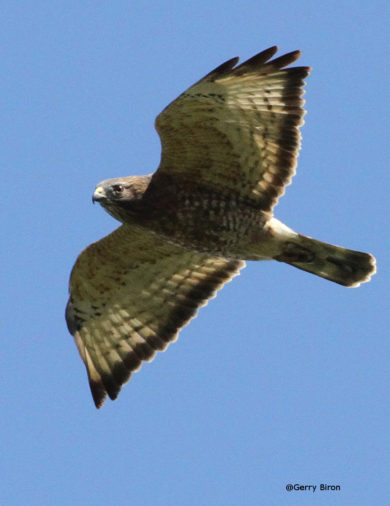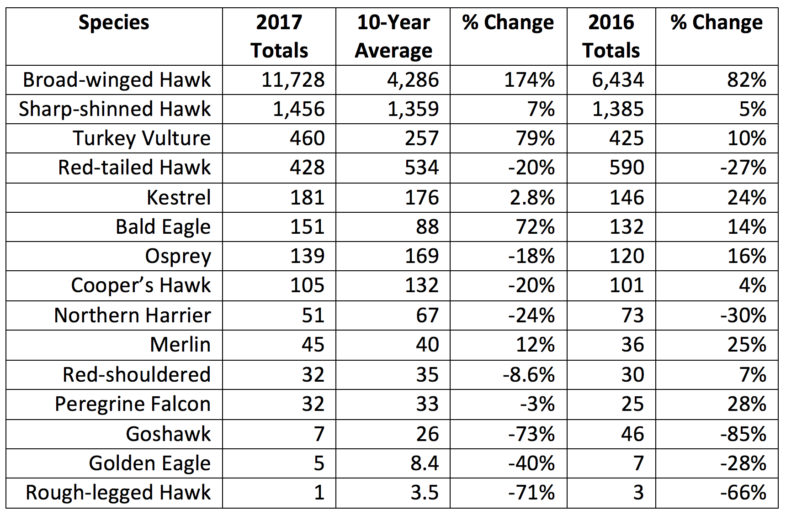By JoAnne Russo
Our 2017 Putney Mountain Hawkwatch season came to an end at 2 pm on November 10th with the temperature just 23 F and winds gusting to over 35 mph. And what a season it was!
On September 19th, we recorded 787 raptors, mostly Broad-winged Hawks, bringing our year-to-date total to 10,728. We broke two records that day: first – recording over 10,000 broad-wings and second – recording over 10,000 migrants passing over the mountain in one season. We eventually counted 11,728 Broad-winged Hawks and topped our previous highest count of 9,866 other raptors set in 2012.
Our final tally of 14,823 raptors for the year reflects both the unprecedented Broad-winged Hawk flight and our commitment to counting the entire year. We also count a few non-raptor migrants, like the 12,092 Canada Geese, 980 Blue Jays and 739 Monarch butterflies that passed by the mountain.
Monarch butterfly populations overwintering in Mexico have been in decline for decades. After a banner year in 2012 with 1,715 counted to an all-time low of just 20 the following year and then counts ranging from 100 to 200 each year, 2017 marks an apparent rebound in populations, a trend noted throughout the Northeast in 2017. Whether this is reflected in overall populations arriving and wintering in Mexico this year remains to be seen.
Putney Mountain is Vermont’s only hawkwatch operated every day during fall migration with reports sent daily to Hawk Migration Association of North America (HMANA). It is entirely run by a dedicated group of volunteers, organized by John Anderson. Sending counts to the Vermont Institute of Natural Science as early as 1974, Putney Mountain’s first hawkwatchers sporadically covered the fall season. In the early 1990s, the site was better organized, coverage improved, and records were sent to HMANA.
During the 2017 season, we covered 72 days, which breaks down to 562 hours and 2,168 watcher hours, averaging about 4 watchers per hour and 8 hours per day. At the close of each season, John tabulates the data and completes an annual report. We’ve noticed trends over the years, for instance, Bald Eagle numbers are increasing while Ospreys have decreased.
The 10-year average and comparison to 2016 totals show a large increase in counts of Broad-winged Hawks this year. Why were the counts so high? Our best guess was the wind! Hurricanes off the east coast in September likely pushed the flight paths to the west, sending the migrants over Putney Mountain. We noticed the numbers of Broad-wings at hawkwatch stations directly to our east were much lower than normal during peak migration, which is around September 10th to the 23rd, give or take a few days.
Weather can also be a factor in delaying migration. For instance, warmer than normal temperatures this fall probably resulted in fewer Red-tailed Hawks leaving in big numbers consistent to “normal” fall numbers. October is usually the month for migrating red-tails, but this year we only tallied 199 compared to 395 averaged over the past three years.
We like to think we can predict approximately how many migrants will pass over Putney Mountain on a given day; considering the temperature, wind direction, wind speed and cloud cover. However, each day is unique; some were absolutely thrilling, some unbelievably dull; some were blazing hot, and others icy cold. Our 2017 season is over, now we look forward to the next season and wonder if we’ll have another record year!



